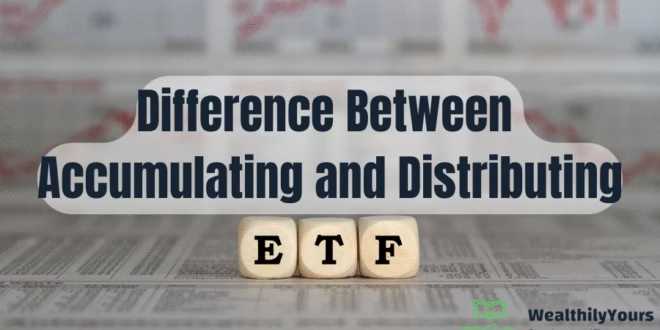When it comes to smart investing in the UK, one of the most common debates is the difference between accumulating and distributing ETF. These two fund types cater to different investor preferences, and understanding the difference between accumulating and distributing ETF is essential for optimising returns, particularly in a tax-conscious and long-term investing strategy.
What is an ETF?
An Exchange-Traded Fund (ETF) is a marketable security that tracks an index, commodity, sector, or asset. ETFs are traded on exchanges like stocks, making them a popular choice among UK investors due to their diversification, low fees, and ease of access.
Also Read: 9 Must know ETF categories for successful investing
Accumulating vs. Distributing ETF: The Basics
The difference between accumulating and distributing ETF lies in how they handle dividends.
- Accumulating ETF: These automatically reinvest any income or dividends back into the fund. You don’t receive cash, but your investment grows over time as dividends are reinvested.
- Distributing ETF: These pay out the dividends to your brokerage account. You receive income periodically, monthly, quarterly, or annually.
By understanding the difference between accumulating and distributing ETF, UK investors can make decisions aligned with their financial goals.
Real-World Example
Let’s say you invest £10,000 in two ETFs, one accumulating and one distributing. Both ETFs track the same index and yield a 3% dividend annually with a 5% capital gain.
Also Read: Detailed review of Franklin FTSE India UCITS ETF
Accumulating ETF
In year one, your dividends are reinvested. By the end of the year, you’ll have £10,800 instead of just £10,500 (capital gains + dividends) due to compound growth.
In 5 years, this compounding effect results in roughly £13,382.
Distributing ETF
You still get the same 3% dividend, but it’s paid out. So, if you don’t reinvest manually, your capital only grows at the capital gains rate. After 5 years, your fund value might be closer to £12,763 (not accounting for reinvestment).
This comparison highlights a core difference between accumulating and distributing ETF returns in the long run.
Pros and Cons
Accumulating ETF
Pros:
- Compounding effect enhances long-term gains
- Better for tax wrappers like ISAs or SIPPs in the UK
- No temptation to spend dividends
Cons:
- Not ideal for investors seeking passive income
- Can be harder to track dividend income for tax purposes (outside ISAs/SIPPs)
Also Read: Top 5 Index Fund ETFs in the UK
Distributing ETF
Pros:
- Generates regular income, ideal for retirees or passive income strategies
- Useful for dividend reinvestment strategies
Cons:
- Dividends may be taxed (outside tax wrappers)
- Missing out on automatic compounding
- Manual reinvestment requires effort and may incur trading fees
UK Tax Implications
UK investors holding ETFs in a Stocks and Shares ISA or SIPP are sheltered from dividend or capital gains taxes. However, outside these wrappers, dividends from distributing ETFs are taxable above the allowance.
Accumulating ETFs complicate tax reporting since reinvested income still counts as taxable in some scenarios. It’s critical to review your annual tax statements or consult a financial advisor.
Which ETF Type is Best for You?
Choosing the right ETF depends on your investment strategy and personal circumstances.
- If you’re young and focused on long-term growth, an accumulating ETF is likely more beneficial due to compound growth.
- If you’re retired or require regular income, a distributing ETF provides direct cash flow.
Once again, the difference between accumulating and distributing ETF becomes relevant when aligning investment behavior with goals.
Also Read: Mutual funds, ETFs vs Direct stocks – which one is best for you?
Final Thoughts
The difference between accumulating and distributing ETF should not be overlooked. For UK investors, both types have advantages depending on age, tax situation, and financial objectives.
Disclaimer
This article is for informational purposes only and does not constitute financial advice. Please consult a certified financial planner or tax advisor before making investment decisions.
Understanding the difference between accumulating and distributing ETF can help UK investors make better decisions aligned with their goals. Whether you’re seeking income or growth, choosing the right ETF type can significantly impact your financial future.
Enjoyed the Post? Share Your Thoughts and Spread the Word!
If you found this blog post informative and helpful, I’d love it if you could share it with your friends, family, or anyone who might benefit from it. Your support helps me reach more readers and continue creating content like this!
Also, I’d love to hear from you! What are your thoughts on the topic? Do you have any questions or insights to add? Drop a comment below - I’m here to chat and learn from your perspective too.
Thank you for being part of this journey, and I can’t wait to hear what you think!
 WealthilyYours Empowering You to Grow, Invest, and Thrive
WealthilyYours Empowering You to Grow, Invest, and Thrive




